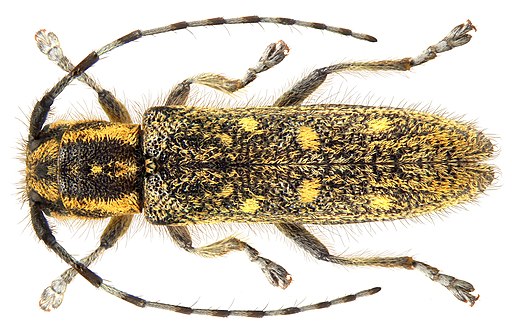Superregnum: Eukaryota
Cladus: Unikonta
Cladus: Opisthokonta
Cladus: Holozoa
Regnum: Animalia
Subregnum: Eumetazoa
Cladus: Bilateria
Cladus: Nephrozoa
Cladus: Protostomia
Cladus: Ecdysozoa
Cladus: Panarthropoda
Phylum: Arthropoda
Subphylum: Hexapoda
Classis: Insecta
Cladus: Dicondylia
Subclassis: Pterygota
Cladus: Metapterygota
Infraclassis: Neoptera
Cladus: Eumetabola
Cladus: Endopterygota
Superordo: Coleopterida
Ordo: Coleoptera
Subordo: Polyphaga
Infraordo: Cucujiformia
Cladus: Phytophaga
Superfamilia: Chrysomeloidea
Familia: Cerambycidae
Subfamilia: Lamiinae
Tribus: Saperdini
Genus: Saperda
Species: Saperda populnea
Subspecies: S. p. lapponica
Name
Saperda populnea (Linnaeus, 1758)
Synonyms
Cerambyx populneus Linnaeus, 1758
References
Primary references
Linnaeus, C. 1758. Systema Naturae per regna tria naturæ, secundum classes, ordines, genera, species, cum characteribus, differentiis, synonymis, locis, Tomus I. Editio decima, reformata. Holmiæ: impensis direct. Laurentii Salvii. i–ii, 1–824 pp DOI: 10.5962/bhl.title.542: 394. Reference page.
Additional references
Wallin, H., Kvamme, T. & Bergsten, J. 2017. To be or not to be a subspecies: description of Saperda populnea lapponica ssp. n. (Coleoptera, Cerambycidae) developing in downy willow (Salix lapponum L.). ZooKeys 691: 101—148. DOI: 10.3897/zookeys.691.12880. Reference page.
Links
Saperda populnea Taxon details on Fauna Europaea
Triba Saperdini: Saperda (Compsidia) populnea (L.) - photo by M.E. Smirnov
ZooBank: E80B9C86-1278-4798-8404-C3FED1D34FBF
Vernacular names
Deutsch: Kleiner Pappelbock
magyar: Kis nyárfacincér
Nederlands: Kleine populierenboktor
polski: Rzemlik osinowiec
русский: Скрипун осиновый малый
Saperda populnea, the small poplar borer,[1] is a species of beetle in the family Cerambycidae which forms woody galls on twigs of poplars and willows. It was described by Carl Linnaeus in 1758.[2]
Description
The beetles can be found from May to July, with the female makes a horseshoe shaped cut and laying an egg in the incision.[3] The gall develops in an internode as a symmetrical swelling, which can be 20 mm long, and contains a yellowish larva or pupa in a single elongate chamber. An exit hole is made in the spring.[4] It is most common on apen (Populus tremula) and also found on black cottonwood (P. trichocarpa), black poplar (P. nigra) and goat willow (Salix caprea).[5] In Britain the gall is commonest on the young twigs of aspen.[4]
Distribution
Has been recorded in the following countries, Albania, Algeria, Austria, Belarus, Belgium, Bosnia and Herzegovina, Bulgaria, Canada, China, Croatia, Czech Republic (Bohemia, Moravia), France, Germany, Hungary, Italy, Japan, Kazakhstan, Luxembourg, Mongolia, Morocco, Mexico, North Korea, Poland, Romania, Russia, Sardinia, Serbia, Sicily, Slovakia, Slovenia, Spain, Sweden, Norway, Switzerland, Turkey, United Kingdom, United States of America.[2]
References
"Saperda populnea (small poplar borer)". www.cabi.org. Retrieved 27 August 2019.
"Saperda populnea (Linnaeus, 1758)". BioLib.cz. Retrieved 28 November 2017.
Harde, K W; Severa, F (2000). A Field Guide In Colour To Beetles. Enderby: Silverdale Books. pp. 268–9. ISBN 1-85605-448-9.
Redfern, Margaret; Shirley, Peter; Bloxham, Michael (2011). British Plant Galls (Second ed.). Shrewsbury: FSC Publications. pp. 210–219 & 282–299. ISBN 978-1-85153-284-1.
Ellis, W N. "Saperda populnea (Linnaeus, 1758)". Plant Parasites of Europe. Retrieved 28 November 2017.
Retrieved from "http://en.wikipedia.org/"
All text is available under the terms of the GNU Free Documentation License


